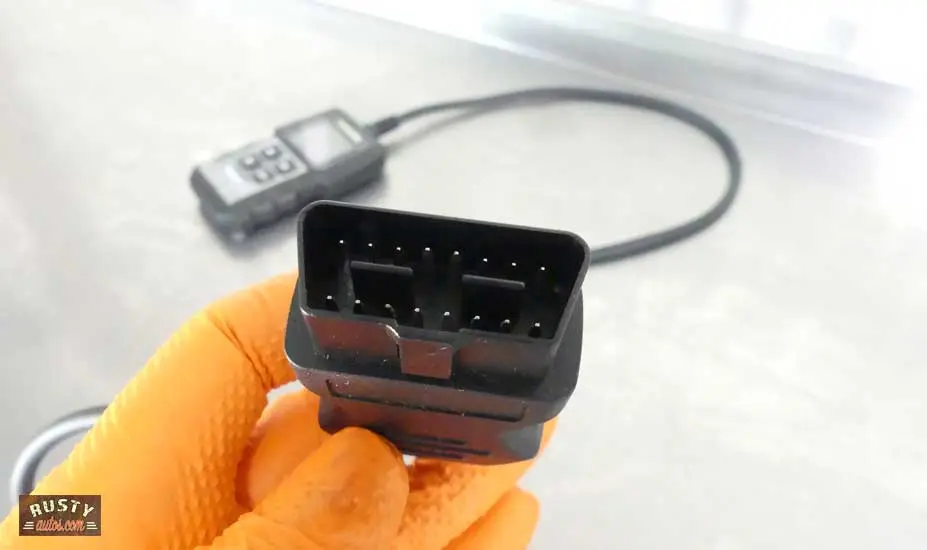The video is dedicated to helping you use a fault code reader. It covers locating your Data Link Connector (DTC) also known as On-Board Diagnostics (OBD) port, connecting the code reader, reading the codes, and clearing the codes.
You’ll find other useful resources on this page, tips, links to tools, parts, and supplies required to troubleshoot.
Code Reader Tips
Here are a few tips for using a fault code reader. Your first task before connecting a code reader is actually finding the DTC port itself. If your vehicle was made in the last ten years or so you won’t have an issue locating the DTC.
However, if your vehicle is fifteen-plus years old don’t underestimate how challenging locating the DTC can be. The engineers really went out of their way to hide them, I have no idea why.
Anyhow, here’s a list of the most common places to find DTC ports.
- Below steering wheel – Most modern vehicles will locate the DTC port in the under-dash close out panel
- Passenger-side glove box – Some latest model vehicles may locate the DTC inside the glove box, but likely it will be obscured by a pull-off panel
- Located inside the fuse box – Some vehicles incorporate the DTC with the interior fuse box, both older and modern vehicles
- Ashtray – Older vehicles may locate the DTC behind the removeable ashtray
- Drinks holder – Older vehicles may locate the DTC beneath the drinksholder
- Center console – Older vehicles may locate the DTC inside the center console storage box
- Drivers side dash board storage areas – Both older and modern vehicles may locate the the DTC inside a storage area, however it usually obscured by a removeable panel, cover or tab
If you still can’t find it, search Google (pictures) your models’ DTC locations.

Scan tools plug will only fit one way
Reading Codes
The video coves the code reading process pretty well, reading codes is easy you just need to remember to turn on the ignition to allow the reader to communicate with the tools. No biggie if you don’t remember, the reader will prompt you.
You should be aware, most small inexpensive code readers will only read powertrain codes (engine and transmission faults) if you’re chasing codes like ABS, SRS, or HVAC system issues, you’ll need a more advanced scanner.
When reading codes be mindful leaving the ignition system in position two for extended periods will drain the battery. This is especially true for diesel trucks, it’s fine to turn on and read your codes but if you want to run some other test functions, it’s advised you use a battery maintainer.

I wrote a post about using the Topdon code reader here. Topdon vs Autel
Clearing Codes
Clearing codes is as easy as reading them. However, before clearing them it’s advised you note the unique fault code. I use my phone camera to keep a record. Keeping track of fault codes is useful for diagnosing intermittent faults.
Clearing a fault code is exactly that, but if the fault is still present the Powertrain Control Module (PCM) will set the engine light again when the engine is started or after three more engines start cycles. The engine fault light doesn’t usually come on without good reason.
That said unusual conditions like extreme weather conditions, unusual terrain, etc. may cause the engine light also known as the MIL (Malfunction Indicator Light) to come on.
A very common cause of an engine light (MIL) is a loose or faulty gas cap. The engine light is set as the PCM has detected a gas tank pressure leak. This in itself isn’t a big issue for the vehicle itself, but it is harmful to the environment and so the MIL is set and some vehicles may enter “Limp mode” (reduced performance).
This of course forces the owner to take the vehicle to the shop. So if your MIL comes on after a gas fill, check and see if the gas cap is tight. If it was the source of your engine light, it will turn itself off.
Fault Finding Tools
Here are the tools I recommend for troubleshooting fault codes.
The Topdon is a perfect code reader for the glovebox of your car, it’s small and effective. Note this scanner will only read powertrain fault codes (engine and transmission). It’s conveniently delivered to your door by Amazon.com.

If you need a tool that can interrogate other systems like SRS, ABS, etc you’ll need a higher-end scanner. Check out the Autel MaxiCOM below.

A Power probe is an excellent tool to have around. Great for testing circuits, relays, fuses, checking battery voltage, checking alternator output, checking the ground, volt drop testing. I’ve had a power probe forever and it’s still going strong.

The NOCO genius battery charger is what’s known as a smart charger also known as a battery maintainer or trickle charger. They are smart because they detect the battery state of charge and automatically turn it off and on as needed.

- About the Author
- Latest Posts
John Cunningham is an Automotive Technician and writer on Rustyautos.com. He’s been a mechanic for over twenty-five years and has worked for GM, Volvo, Volkswagen, Land Rover, and Jaguar dealerships.
John uses his know-how and experience to write fluff-free articles that help fellow gearheads with all aspects of vehicle ownership, including maintenance, repair, and troubleshooting.

